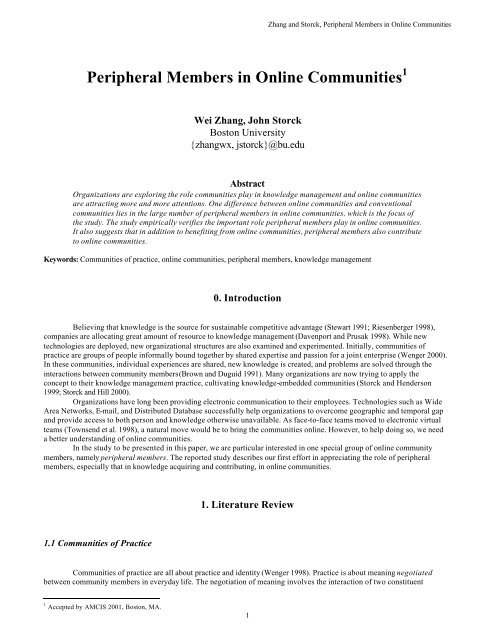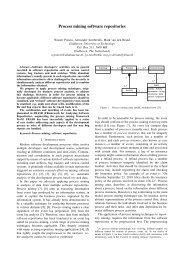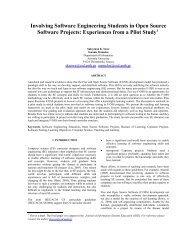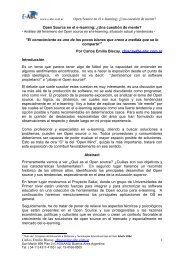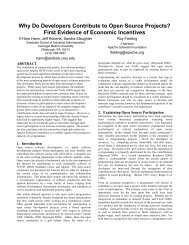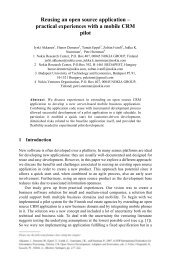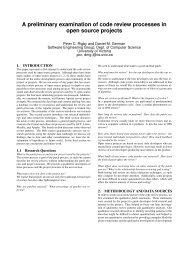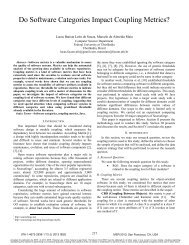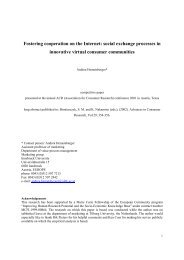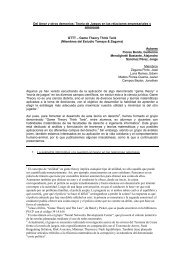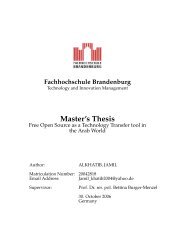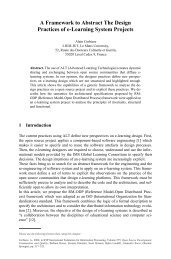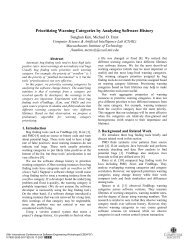Peripheral Members in Online Communities - IFIP Working Group 2.13
Peripheral Members in Online Communities - IFIP Working Group 2.13
Peripheral Members in Online Communities - IFIP Working Group 2.13
You also want an ePaper? Increase the reach of your titles
YUMPU automatically turns print PDFs into web optimized ePapers that Google loves.
Zhang and Storck, <strong>Peripheral</strong> <strong>Members</strong> <strong>in</strong> Onl<strong>in</strong>e <strong>Communities</strong><br />
<strong>Peripheral</strong> <strong>Members</strong> <strong>in</strong> Onl<strong>in</strong>e <strong>Communities</strong> 1<br />
Wei Zhang, John Storck<br />
Boston University<br />
{zhangwx, jstorck}@bu.edu<br />
Abstract<br />
Organizations are explor<strong>in</strong>g the role communities play <strong>in</strong> knowledge management and onl<strong>in</strong>e communities<br />
are attract<strong>in</strong>g more and more attentions. One difference between onl<strong>in</strong>e communities and conventional<br />
communities lies <strong>in</strong> the large number of peripheral members <strong>in</strong> onl<strong>in</strong>e communities, which is the focus of<br />
the study. The study empirically verifies the important role peripheral members play <strong>in</strong> onl<strong>in</strong>e communities.<br />
It also suggests that <strong>in</strong> addition to benefit<strong>in</strong>g from onl<strong>in</strong>e communities, peripheral members also contribute<br />
to onl<strong>in</strong>e communities.<br />
Keywords: <strong>Communities</strong> of practice, onl<strong>in</strong>e communities, peripheral members, knowledge management<br />
0. Introduction<br />
Believ<strong>in</strong>g that knowledge is the source for susta<strong>in</strong>able competitive advantage (Stewart 1991; Riesenberger 1998),<br />
companies are allocat<strong>in</strong>g great amount of resource to knowledge management (Davenport and Prusak 1998). While new<br />
technologies are deployed, new organizational structures are also exam<strong>in</strong>ed and experimented. Initially, communities of<br />
practice are groups of people <strong>in</strong>formally bound together by shared expertise and passion for a jo<strong>in</strong>t enterprise (Wenger 2000).<br />
In these communities, <strong>in</strong>dividual experiences are shared, new knowledge is created, and problems are solved through the<br />
<strong>in</strong>teractions between community members(Brown and Duguid 1991). Many organizations are now try<strong>in</strong>g to apply the<br />
concept to their knowledge management practice, cultivat<strong>in</strong>g knowledge-embedded communities (Storck and Henderson<br />
1999; Storck and Hill 2000).<br />
Organizations have long been provid<strong>in</strong>g electronic communication to their employees. Technologies such as Wide<br />
Area Networks, E-mail, and Distributed Database successfully help organizations to overcome geographic and temporal gap<br />
and provide access to both person and knowledge otherwise unavailable. As face-to-face teams moved to electronic virtual<br />
teams (Townsend et al. 1998), a natural move would be to br<strong>in</strong>g the communities onl<strong>in</strong>e. However, to help do<strong>in</strong>g so, we need<br />
a better understand<strong>in</strong>g of onl<strong>in</strong>e communities.<br />
In the study to be presented <strong>in</strong> this paper, we are particular <strong>in</strong>terested <strong>in</strong> one special group of onl<strong>in</strong>e community<br />
members, namely peripheral members. The reported study describes our first effort <strong>in</strong> appreciat<strong>in</strong>g the role of peripheral<br />
members, especially that <strong>in</strong> knowledge acquir<strong>in</strong>g and contribut<strong>in</strong>g, <strong>in</strong> onl<strong>in</strong>e communities.<br />
1. Literature Review<br />
1.1 <strong>Communities</strong> of Practice<br />
<strong>Communities</strong> of practice are all about practice and identity (Wenger 1998). Practice is about mean<strong>in</strong>g negotiated<br />
between community members <strong>in</strong> everyday life. The negotiation of mean<strong>in</strong>g <strong>in</strong>volves the <strong>in</strong>teraction of two constituent<br />
1 Accepted by AMCIS 2001, Boston, MA.<br />
1
Zhang and Storck, <strong>Peripheral</strong> <strong>Members</strong> <strong>in</strong> Onl<strong>in</strong>e <strong>Communities</strong><br />
processes: participation and reification. Participation refers both to the process of tak<strong>in</strong>g part and to the relations with others<br />
that reflects this process. Reification refers to the process of giv<strong>in</strong>g form to member experience by produc<strong>in</strong>g objects that<br />
congeal this experience <strong>in</strong>to "th<strong>in</strong>gness".<br />
Practice def<strong>in</strong>es a community through three dimensions: mutual engagement, jo<strong>in</strong>t enterprise, and shared repertoire.<br />
Identity is produced as a lived experience of participation <strong>in</strong> specific communities. One’s identity is built and ma<strong>in</strong>ta<strong>in</strong>ed<br />
through practice, and recognized by other members <strong>in</strong> the practice. In this sense, the dimensions of practice become<br />
dimensions of identity: a competent member should possess mutuality of engagement, accountability to the jo<strong>in</strong>t enterprise,<br />
and negotiability of the repertoire.<br />
1.2 Onl<strong>in</strong>e <strong>Communities</strong>: how they are different<br />
In the last several years, numerous onl<strong>in</strong>e communities burgeon on Internet. We discuss below the differences<br />
between onl<strong>in</strong>e communities and conventional communities of practice.<br />
?? Open <strong>Members</strong>hip: <strong>Communities</strong> of practice are open social systems, but not boundary-less. Access to them is<br />
not available to anybody. In fact, one has to get legitimacy before participat<strong>in</strong>g (Lave and Wenger 1991, p35). In onl<strong>in</strong>e<br />
communities, especially those without written membership criteria, the number of members can be <strong>in</strong>f<strong>in</strong>ite. As long as one is<br />
connected, he can jo<strong>in</strong> any onl<strong>in</strong>e community he wants and he can reach all its members easily. The larger the member base,<br />
the more knowledge brought to the community by the members. The connections between members could be far and weak,<br />
but they have their own advantages and can contribute to problem solv<strong>in</strong>g and new knowledge creation (Friedk<strong>in</strong> 1982).<br />
?? Computer-mediated Communication: Face-to-face talk<strong>in</strong>g is the dom<strong>in</strong>ant communication method <strong>in</strong><br />
conventional communities. The cost of narration and collaboration – the two process that enable community members to<br />
share knowledge and create new knowledge (Brown and Duguid 1991) – is low. Besides, face-to-face talk<strong>in</strong>g <strong>in</strong>volves more<br />
social cues (Sproull and Kiesler 1986), which helps to establish member identities. In onl<strong>in</strong>e communities, communications<br />
are computer-mediated. In most cases, members talk to each other through text -based, electronic communication. Compared<br />
with face-to-face talk<strong>in</strong>g, Computer-mediated communication (CMC )is th<strong>in</strong>ner (Daft and Lengel 1986), thus less a choice<br />
for knowledge work, which features both high uncerta<strong>in</strong>ty and high equivocality. However, the asynchronous nature (Hiltz<br />
and Turoff 1978) and the ability to reach all members easily (Markus 1994) of CMC may make up for the disadvantage.<br />
Previous research on email use demonstrated two dimensions on CMC: task-related and socioemotional (Ste<strong>in</strong>field<br />
1986). Examples of task-related use are coord<strong>in</strong>at<strong>in</strong>g projects, monitor<strong>in</strong>g progress, and distribut<strong>in</strong>g/provid<strong>in</strong>g <strong>in</strong>formation.<br />
Social use <strong>in</strong>cludes ma<strong>in</strong>ta<strong>in</strong><strong>in</strong>g relationships and organiz<strong>in</strong>g a social activity. In onl<strong>in</strong>e communities, everyth<strong>in</strong>g is <strong>in</strong> flux:<br />
memberships are negotiated; members come and go; jo<strong>in</strong>t enterprises will change as the communities evolve; shared<br />
repositories grow over time; and communities may last for a long period of time. A substantial part of communications has to<br />
be about the community itself: its mutual engagement, jo<strong>in</strong>t enterprise, and shared repository. Thus, community-related<br />
communications should comprise the third dimension of CMC <strong>in</strong> onl<strong>in</strong>e communities.<br />
?? Segregated Practice: In conventional communities of practice, where the community members meet is where<br />
the practice goes on. Participation and reification are <strong>in</strong>terweaved <strong>in</strong> face-to-face conversations between members (Wenger<br />
1998, p62). In virtual community, members are geographically dispersed. Their practice actually consists of two parts: the<br />
task practice and the community practice. Task practice is the doma<strong>in</strong> task members perform. It reflects the jo<strong>in</strong>t enterprise of<br />
the community. Community practice happens when they “talk” with each other. For a group of soap TV lovers (Baym 1999),<br />
the task practice is to watch the soap TV programs at their homes; the community practice is to communicate with each other<br />
on their <strong>in</strong>dividual task practice: they would talk about their feel<strong>in</strong>gs about a role or exchange <strong>in</strong>formation perta<strong>in</strong><strong>in</strong>g to the<br />
program they were watch<strong>in</strong>g. We call this phenomenon segregated practice to characterize the separation of task practice<br />
from community practice.<br />
Two implications of segregated practice deserve further attention. The first is that social and community-related<br />
communications may be more prom<strong>in</strong>ent <strong>in</strong> onl<strong>in</strong>e communities than <strong>in</strong> conventional communities, s<strong>in</strong>ce task practice does<br />
not allow many chances for both k<strong>in</strong>ds of communications. The second is that s<strong>in</strong>ce task practice is separate from community<br />
practice, the identity a member ga<strong>in</strong>s from participat<strong>in</strong>g <strong>in</strong> community practice may not consist with his experiences <strong>in</strong> task<br />
practice.<br />
?? Recorded History: In conventional communities, history, if not <strong>in</strong>tentionally recorded, rema<strong>in</strong>s distributed <strong>in</strong> the<br />
memories of community members. Access<strong>in</strong>g history requires <strong>in</strong>teract<strong>in</strong>g with different community members and <strong>in</strong>tegrat<strong>in</strong>g<br />
<strong>in</strong>formation from multiple sources. In onl<strong>in</strong>e community, CMC can be easily stored and further processed to facilitate<br />
purposeful browse or search. Part of the history of a virtual community is naturally recorded as the practice is go<strong>in</strong>g on. Such<br />
records draw a holistic picture about the community. As a result, read<strong>in</strong>g the history makes it easier for newcomers to blend<br />
<strong>in</strong>to the community and participate <strong>in</strong> its practice.<br />
1.3 <strong>Peripheral</strong> <strong>Members</strong> <strong>in</strong> Onl<strong>in</strong>e <strong>Communities</strong><br />
2
Zhang and Storck, <strong>Peripheral</strong> <strong>Members</strong> <strong>in</strong> Onl<strong>in</strong>e <strong>Communities</strong><br />
The open access to onl<strong>in</strong>e communities br<strong>in</strong>gs numerous members to them. Among them, most are seldom heard to<br />
other members (Baym 1999). Even <strong>in</strong> relatively closed case such as email distribution lists, only a small portion of members<br />
participate frequently on a regular base (F<strong>in</strong>holt and Sproull 1990). Among those who are not so active, some are pure<br />
observers and totally <strong>in</strong>visible to others. Due to the difficulty <strong>in</strong> reach these members, we excluded them <strong>in</strong> this study. Some<br />
are light participants, rais<strong>in</strong>g voice occasionally dur<strong>in</strong>g a long period of time. In this study, such members are called<br />
peripheral members.<br />
The first difference between “peripheral members” here and “peripheral members” <strong>in</strong> Lave and Wenger (1991) is<br />
visibility. In conventional communities, members have to show up <strong>in</strong> person to participate, thus mak<strong>in</strong>g themselves visible to<br />
others. In onl<strong>in</strong>e communities, peripheral members are less visible <strong>in</strong> that if they don’t participate, only they themselves<br />
know their existence (F<strong>in</strong>holt and Sproull 1990). The second difference is that <strong>in</strong> conventional communities, “peripheral<br />
members” are related to “core members” or “full members”. Learn<strong>in</strong>g can be viewed <strong>in</strong> terms of the identity change: from<br />
peripheral members to core members. In onl<strong>in</strong>e communities, due to the large number of peripheral members and their<br />
<strong>in</strong>visibility, only a relatively few peripheral members will become core members over time. Chances are most peripheral<br />
members will keep be<strong>in</strong>g peripheral. By us<strong>in</strong>g the term “peripheral members”, we don’t mean to juxtapose it with “core<br />
members”, and don’t implicate any necessity or <strong>in</strong>tention of the identity change as <strong>in</strong> conventional communities of practice.<br />
The role of peripheral members <strong>in</strong> onl<strong>in</strong>e communities is <strong>in</strong>trigu<strong>in</strong>g and has been little researched so far. In the next<br />
section, we list research questions that we were go<strong>in</strong>g to address <strong>in</strong> this paper.<br />
2. Research Questions<br />
It is widely accepted that there are <strong>in</strong>deed many peripheral members <strong>in</strong> an open onl<strong>in</strong>e community. But still, how<br />
many is many and how peripheral is peripheral? Thus our first research questions concerns def<strong>in</strong><strong>in</strong>g the “peripheral”:<br />
Q1. What is the participation pattern of the community members and how many of them are peripheral?<br />
Less participat<strong>in</strong>g, peripheral members bear less recognizable identity <strong>in</strong>formation with them, which would put the<br />
members <strong>in</strong>to a disadvantaged position <strong>in</strong> practices <strong>in</strong> conventional communities. In an onl<strong>in</strong>e community, the CMC and<br />
recorded history can help peripheral members understand the community without hav<strong>in</strong>g to engage with other members.<br />
When needed, they are able to post messages consistent with the communities’ jo<strong>in</strong>t enterprise and thus contribute to the<br />
practices. Social communication may be more problematic. Read<strong>in</strong>g the message exchanged between members will of course<br />
familiarize peripheral members with the relationships <strong>in</strong> the community to a certa<strong>in</strong> degree. But jump<strong>in</strong>g <strong>in</strong>to the<br />
relationships and socialize with other members will be difficult without regular engagements between members. Hence, we<br />
wonder:<br />
Q2. Do peripheral members <strong>in</strong> onl<strong>in</strong>e communities communicate differently from non-peripheral members?<br />
As conventional communities of practice, onl<strong>in</strong>e communities can facilitate knowledge exchange between<br />
community members (Faraj and Wasko 2000). Our third research question is about the roles peripheral members play <strong>in</strong> the<br />
process:<br />
Q3. Are peripheral members different from non-peripheral members as far as knowledge acquir<strong>in</strong>g and knowledge<br />
contribut<strong>in</strong>g are concerned?<br />
3. Methodology<br />
The selected community is a travel forum hosted by a major Internet <strong>in</strong>formation service company <strong>in</strong> Ch<strong>in</strong>a.<br />
Basically, it is a moderated onl<strong>in</strong>e message board, equipped with some search<strong>in</strong>g tools. At one time, it may have one or more<br />
hosts 2 . The company also holds many other onl<strong>in</strong>e communities. The travel forum is selected for reasons beyond our access<br />
to it. First, it has been active for more than two years, and has shown no sign of slow<strong>in</strong>g down. It is more stable than most<br />
other communities (Rice and Love 1987). Second, it is an active community. In average, more than 100 new messages are<br />
posted everyday.<br />
The communication <strong>in</strong> the community is through text -based messages. <strong>Members</strong> can post a new message to <strong>in</strong>itiate<br />
a new thread, or reply to a posted message to jo<strong>in</strong> an exist<strong>in</strong>g thread. The messages appear on the board <strong>in</strong> threaded format<br />
for about one week and then are deleted. The forum ma<strong>in</strong>ta<strong>in</strong>s a best-article collection, essentially the most important part of<br />
a shared repertoire. Forum members make extensive use of it. Many would consult it when they make their own travel plans.<br />
Inquir<strong>in</strong>g members are also often directed to it.<br />
2 See http://abcnews.go.com/sections/tech/DailyNews/ch<strong>in</strong>a_webpolice000125.html as of Feb 19th, 2001 for more<br />
<strong>in</strong>formation on hosts.<br />
3
Zhang and Storck, <strong>Peripheral</strong> <strong>Members</strong> <strong>in</strong> Onl<strong>in</strong>e <strong>Communities</strong><br />
Messages were periodically downloaded from the travel forum dur<strong>in</strong>g the period from June 10th to July 28th 2000.<br />
The messages used for analysis belong to threads <strong>in</strong>itiated between June 9th and July 21st, 2000, when there was no major<br />
holiday. The six-week period are picked to control for daily peaks. Each message’s subject, content, author, post<strong>in</strong>g time are<br />
recorded. Among the messages, those <strong>in</strong> threads <strong>in</strong>itiated between July 8th and July 14 th were coded to decide the use of<br />
communication. The ma<strong>in</strong> purpose for choos<strong>in</strong>g message <strong>in</strong> only one week is to make the cod<strong>in</strong>g manageable with limited<br />
time and resource but still allow<strong>in</strong>g enough time for community members to read and respond to the messages without los<strong>in</strong>g<br />
control of daily peaks.<br />
Due to the time limitation, cod<strong>in</strong>g was conducted by one of the authors, and there was no reliability check.<br />
Consider<strong>in</strong>g the research’s explorative nature, we believe it was an acceptable expedient. The recruit<strong>in</strong>g of <strong>in</strong>dependent<br />
coders has been planned and will be implemented dur<strong>in</strong>g the next a couple of months. The unit of analysis for cod<strong>in</strong>g was the<br />
message. The coder tried to put each message <strong>in</strong>to one of four categories: task-related, social, community-related, or illegal.<br />
The illegal category consisted of the messages that violate the jo<strong>in</strong>t enterprise of the commu nity and therefore, should not be<br />
posted <strong>in</strong> the forum.<br />
To measure members’ participation <strong>in</strong> the explicit knowledge acquir<strong>in</strong>g and knowledge contribut<strong>in</strong>g, task-related<br />
messages perta<strong>in</strong><strong>in</strong>g to knowledge exchange were further classified <strong>in</strong>to two sub-categories: knowledge acquir<strong>in</strong>g and<br />
knowledge contribut<strong>in</strong>g. Knowledge acquir<strong>in</strong>g messages are those with which a member request <strong>in</strong>formation or knowledge<br />
from other members. Knowledge contribut<strong>in</strong>g messages are those with which a member 1) answers to a request from other<br />
members for certa<strong>in</strong> <strong>in</strong>formation or knowledge, or 2) takes part <strong>in</strong> a discussion by jo<strong>in</strong><strong>in</strong>g <strong>in</strong> an exist<strong>in</strong>g thread, or 3)<br />
contributes his experience or knowledge by <strong>in</strong>itiat<strong>in</strong>g a new thread. Note that not all task-related messages are about<br />
knowledge exchang<strong>in</strong>g. For example, many messages try to coord<strong>in</strong>ate member activities, i.e., seek<strong>in</strong>g a travel partner.<br />
In the next section, we present the result. First we present data perta<strong>in</strong><strong>in</strong>g to the participation of community<br />
members. Based on the data, peripheral memb ers are def<strong>in</strong>ed. We then present two comparisons between peripheral members<br />
and non-peripheral members regard<strong>in</strong>g Question 2and Question 3.<br />
4. Results<br />
4.1 Def<strong>in</strong><strong>in</strong>g <strong>Peripheral</strong> <strong>Members</strong><br />
S<strong>in</strong>ce members’ task practice is out of reach, we focused on the community practice and measured member’s<br />
participation with four different variables: number of messages posted, number of threads <strong>in</strong>itiated, number of threads<br />
participated, and tenure, which is the numbers of days between the time stamps of a member’s first and last message. 1065<br />
different members posted the 9590 messages <strong>in</strong> 2123 threads sampled. As observed by other researchers, the level of<br />
participation is not equal between members (Figure 1, 2 , 3 and 4).<br />
Table 1 shows the correlations between the four variables. The correlations between any pair of the variables are at<br />
least 0.5 and are significant at 0.01 level, suggest<strong>in</strong>g that the four variables are somehow equivalent <strong>in</strong> measur<strong>in</strong>g the<br />
members’ participation <strong>in</strong> community practices. Hence, we based our def<strong>in</strong>ition on peripheral members solely on the number<br />
of messages posted: a peripheral member is a member who posted 30 or less messages dur<strong>in</strong>g the sampl<strong>in</strong>g period. The basis<br />
for this selection was that the number of messages posted by all peripheral members is about the same as that of messages<br />
posted by all non-peripheral members, as shown <strong>in</strong> Table 2.<br />
Figure 1: Participation Level of <strong>Members</strong> Measured<br />
by Number of Messages Posted<br />
Figure 2: Number of Threads Initiated by <strong>Members</strong><br />
4
Zhang and Storck, <strong>Peripheral</strong> <strong>Members</strong> <strong>in</strong> Onl<strong>in</strong>e <strong>Communities</strong><br />
Figure 3: Number of Threads Participated by Authors<br />
Figure 4: Lifespan of <strong>Members</strong><br />
Table 1: Correlations Between Four Measurements of<br />
Member Participation <strong>in</strong> Community Practice<br />
Number of<br />
Massages<br />
Posted<br />
Number of<br />
Threads<br />
Initiated<br />
Number of<br />
Threads<br />
Participated<br />
Member<br />
Lifespan<br />
Number of<br />
Massages<br />
Posted<br />
** p < 0.01 (2-tailed).<br />
-<br />
Number<br />
of<br />
Threads<br />
Initiated<br />
0.723 ** -<br />
Number of<br />
Threads<br />
Participated<br />
0.982 ** 0.700 ** -<br />
Member<br />
Lifespan<br />
0.572 ** 0.514 ** 0.572 ** -<br />
Table 2: <strong>Peripheral</strong> <strong>Members</strong> vs. Non-peripheral<br />
<strong>Members</strong><br />
Whole<br />
Data Set<br />
Coded<br />
Data Set<br />
Member Category<br />
<strong>Peripheral</strong><br />
Nonperipheral<br />
Number of <strong>Members</strong> 987 78<br />
Average Number of<br />
Messages Posted<br />
Total Number of<br />
Messages Posted<br />
4.88 61.24<br />
4813 4777<br />
Number of <strong>Members</strong> 291 62<br />
Average Number of<br />
Messages Posted<br />
Total Number of<br />
Messages Posted<br />
2.04 7.68<br />
594 509<br />
Under this criterion, 987 of 1065 members who had ever posted a message dur<strong>in</strong>g the sampl<strong>in</strong>g period were<br />
classified as peripheral members. In another word, 92.68% of all members of the onl<strong>in</strong>e community were peripheral<br />
members. They accounted for about half of the messages posted dur<strong>in</strong>g the sampl<strong>in</strong>g period.<br />
4.2 <strong>Peripheral</strong> <strong>Members</strong> vs. Non-peripheral <strong>Members</strong><br />
Among the 1103 coded messages, peripheral members posted 594 (Table 2). Direct compar<strong>in</strong>g peripheral members<br />
with non-peripheral members will be difficult s<strong>in</strong>ce the data po<strong>in</strong>ts is heavily skewed toward peripheral members. We<br />
aggregated the data on peripheral members and computed the percentages of each of the four communication uses among all<br />
messages posted. Then, we compare the percentages of non-peripheral members with the aggregated data us<strong>in</strong>g one-sample t-<br />
test. Table 3 summarizes the results of the t-tests.<br />
There are two <strong>in</strong>terest<strong>in</strong>g results <strong>in</strong> the table. The first is that peripheral members seemed to be more focused on the<br />
task of onl<strong>in</strong>e community than non-peripheral members(t = -3.60 , df = 61, p < 0.001 ), maybe because non-peripheral<br />
members socialize more than peripheral members (t = 4.58, df =61 , p = 0.000). The second is that there is no significant<br />
difference at 0.05 level between the two populations regard<strong>in</strong>g unfitted communications (t = -1.67, df = 61, p = 0.10). As far<br />
as community-related communication is concerned, percentages for both were low, but that of peripheral members is<br />
significantly higher than that of non-peripheral members (t = -7.72, df = 61, p = 0.000).<br />
5
Zhang and Storck, <strong>Peripheral</strong> <strong>Members</strong> <strong>in</strong> Onl<strong>in</strong>e <strong>Communities</strong><br />
4.3 Knowledge Acquir<strong>in</strong>g and Knowledge Contribut<strong>in</strong>g by <strong>Peripheral</strong> <strong>Members</strong><br />
Similarly to what we do <strong>in</strong> 4.2, we aggregate the knowledge acquir<strong>in</strong>g and knowledge contribut<strong>in</strong>g data on<br />
peripheral members and one-sample t-tests were conducted. Table 4 shows the results.<br />
Two sets of comparison were conducted: the percentage of knowledge acquir<strong>in</strong>g messages and knowledge<br />
contribut<strong>in</strong>g messages to task-related communications and to all communications, respectively. <strong>Peripheral</strong> members benefit<br />
significantly mo re from the knowledge exchang<strong>in</strong>g <strong>in</strong> the community. They are much more likely to request <strong>in</strong>formation<br />
from the onl<strong>in</strong>e community ( t = -4.34, df = 47, p = 0.000 and t = -5.06, df = 61, p = 0.000, respectively.). Among taskrelated<br />
communications, non-peripheral members’ participation <strong>in</strong> knowledge exchang<strong>in</strong>g <strong>in</strong> onl<strong>in</strong>e communities are more<br />
knowledge contribut<strong>in</strong>g (t = 5.12, df = 47, p = 0.000). But surpris<strong>in</strong>gly, when we take all communications <strong>in</strong>to consideration,<br />
peripheral members’ knowledge contribution would equal that of non-peripheral members (t = -0.47, df = 61, p = 0.64).<br />
Table 3: Compar<strong>in</strong>g Communication Percentages of<br />
non-peripheral members aga<strong>in</strong>st peripheral members<br />
Percentage Test value t df<br />
Task-related<br />
communication<br />
Social<br />
communication<br />
Community-related<br />
communication<br />
Unfitted<br />
communication<br />
***: p
Zhang and Storck, <strong>Peripheral</strong> <strong>Members</strong> <strong>in</strong> Onl<strong>in</strong>e <strong>Communities</strong><br />
survey<strong>in</strong>g community members. For example, we have no <strong>in</strong>formation about communication between members outside the<br />
forum. Therefore, we were not able to evaluate the impact of such back-channel communication on the community. Also, we<br />
didn’t measure the quality of members’ participation, which cannot be obta<strong>in</strong>ed without survey<strong>in</strong>g the members <strong>in</strong>volved.<br />
5.2 Future Research<br />
To deepen our understand<strong>in</strong>g of onl<strong>in</strong>e communities and peripheral members, future research from different<br />
perspectives is needed. We are especially <strong>in</strong>terested <strong>in</strong> the follow<strong>in</strong>g.<br />
First, this study confirms the importance of peripheral members as a whole to the forum. Due to the difficulties <strong>in</strong><br />
reach<strong>in</strong>g <strong>in</strong>dividual peripheral member and the number of peripheral members, the study doesn’t reveal exactly how<br />
<strong>in</strong>dividual peripheral members benefit from and contribute to the community. We don’t know specifically what attracts<br />
peripheral members to the community and why they contribute their knowledge to other members. Answers to these<br />
questions would draw a more complete picture of the role of peripheral members <strong>in</strong> an onl<strong>in</strong>e community of practice.<br />
Second, the onl<strong>in</strong>e community is about travel, which is not work-related. Research found that there are significant<br />
differences between work-related electronic groups and non-work related electronic groups (F<strong>in</strong>holt & Sproull 1990). When<br />
onl<strong>in</strong>e communities are concerned, will the members <strong>in</strong> a work-related community behave differently than those <strong>in</strong> a nonwork<br />
related community? And if yes, how? A multiple-site case study of work-related communities <strong>in</strong> real organizations will<br />
be able to answer these questions.<br />
Third, the community studied is a Ch<strong>in</strong>ese community hosted by a company. Is the community affected by the<br />
company’s bus<strong>in</strong>ess philosophy and bus<strong>in</strong>ess model? Does the unique diffusion of the Internet and World Wide Web <strong>in</strong><br />
Ch<strong>in</strong>a, as well as the Ch<strong>in</strong>ese culture, affect members’ onl<strong>in</strong>e behavior? The subject population studied may have a different<br />
view of the Web and of other users of the Web than other populations. A cross-cultural research on these issues seems<br />
extremely <strong>in</strong>trigu<strong>in</strong>g.<br />
References:<br />
Baym, N. K. Tune <strong>in</strong>, log on: Soaps, fandom, and onl<strong>in</strong>e community, Sage Publications, Inc., 1990.<br />
Brown, J. S. and Duguid, P. Organizational learn<strong>in</strong>g and communities of practice: toward a unified view of work<strong>in</strong>g,<br />
learn<strong>in</strong>g, and <strong>in</strong>novation. Organization Science (2,1), 1991, 40-57.<br />
Daft, R. L. and Lengel, R. H. Organizational Information Requirements, Media Richness and Structural Design.<br />
Managaement Science (32,5), 1986, 554-571.<br />
Davenport, T. H. and Prusak, L. Work<strong>in</strong>g Knowledge: How Organizations Management What They Know. Boston, MA:<br />
Harvard Bus<strong>in</strong>ess School Press, 1998.<br />
F<strong>in</strong>holt, T. and Sproull, L. S. Electronic groups at work. Organization Science (1,1), 1990, 41-64.<br />
Friedk<strong>in</strong>, N. Information Flow Through Strong and Weak Ties <strong>in</strong> Intraorganizational Social Networks. Social Networks (3),<br />
1982, 273-285.<br />
Hiltz, S. R. and Turoff, M. The network nation: Human communication via computer. Read<strong>in</strong>g, MA: Addison - Wesley, 1978<br />
Lave, J. and Wenger, E. Situated Learn<strong>in</strong>g: Legitimate peripheral participation, Cambridge University Press, 1991.<br />
Markus, M. L. Electronic mail as the medium of managerial choice. Organization Science (5,4), 1994, 502-527.<br />
Rice, R. E. and G. Love. Eletro<strong>in</strong>c Emotion: Socioemotional Content <strong>in</strong> a Computer-Mediated Communication Network.<br />
Communication Research (14,1), 1987, 85-108.<br />
Riesenberger, J. R. Knowledge -- The Source of Susta<strong>in</strong>able Competitive Advantage. Journal of International Market<strong>in</strong>g<br />
(6,3),1998, 94-107.<br />
Sproull, L., and Kiesler, S. Reduc<strong>in</strong>g social context cues: Electronic mail <strong>in</strong> organizational communication. Management<br />
Science (32,11), 1986, 1492-1512.<br />
Ste<strong>in</strong>field, C. W. Computer-Mediated Communication <strong>in</strong> an Organizational Sett<strong>in</strong>g: Expla<strong>in</strong><strong>in</strong>g Task-related and<br />
Socioemotional Uses. Communication Yearbook (9), 1986, 777-804.<br />
Stewart, T. A. Bra<strong>in</strong>power. Fortune (June 3), 1991, 44-60.<br />
Storck, J. and Henderson, J. Shap<strong>in</strong>g the Bus<strong>in</strong>ess Model <strong>in</strong> the 21st Century: The Role of <strong>Communities</strong> of Practice. Boston<br />
Univerisity Work<strong>in</strong>g Paper, 1999.<br />
Storck, J. and Hill, P. A. Manag<strong>in</strong>g Global Infrastructure: A Strategic Community Bulilds Strategic Capabilities. Sloan<br />
Management Review. (41,2), 2000, 63-74.<br />
Townsend, A. M., DeMarie, S. M. and Hendrickson, A. R. Virtual teams: Technology and the workplace of the future. The<br />
Academy of Management Executive (12,3), 1998, 17-29.<br />
Wenger, E. <strong>Communities</strong> of Practice: Learn<strong>in</strong>g, mean<strong>in</strong>g and identity, Cambridge University Press, 1998.<br />
Wenger, E. <strong>Communities</strong> of practice: The organizational frontier. Harvard Bus<strong>in</strong>ess Review (78,1),2000, 139 - 144.<br />
7


